Piedmont Vegetation Spotlight: Dry Oak – Mixed Hardwood Forests
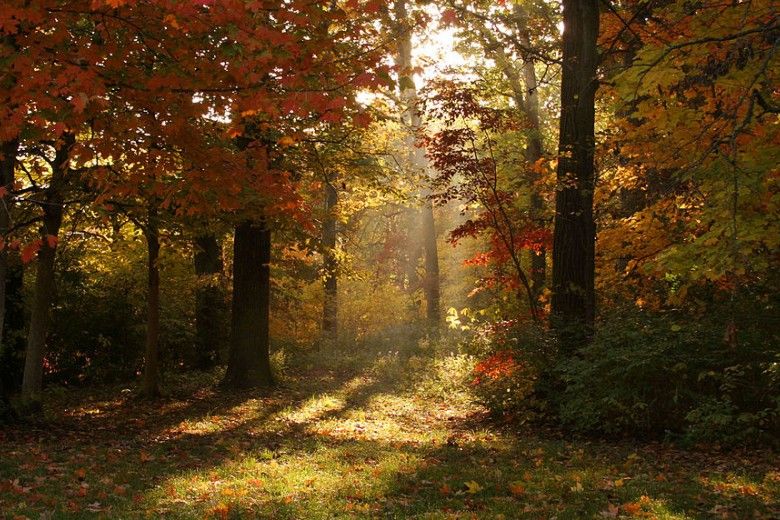
Join us as we continue our exploration of the vegetative communities of the Piedmont region of the Eastern United States. In this new series of blogs, we'll be spotlighting specific vegetative communities, define their historic structures, describe the processes that created them, examine past and ongoing threats to their survival, and provide suggestions for long-term, sustainable forest management to help steward them into the future.
In the previous spotlight, we highlighted Tuliptree – Beech – Maple Forests, which are mesic hardwood forests found commonly on former agricultural sites with moderate nutrient and moisture availability. In this spotlight, we’ll discuss the drier “Dry Oak – Mixed Hardwood Forests,” which were historically abundant throughout the Mid-Atlantic and the Piedmont region, where they were both economically and ecologically valuable. Decades of exploitative logging, fire suppression, and under-management, combined with pressure from forest pests and pathogens, altered many of these communities and challenge their future health. Understanding the essential role of natural ecological disturbances, such as wildfires, in shaping these communities is key to designing management plans that ensure the restoration and continued health of any vegetative community and Dry Oak – Mixed Hardwood Forests in particular.
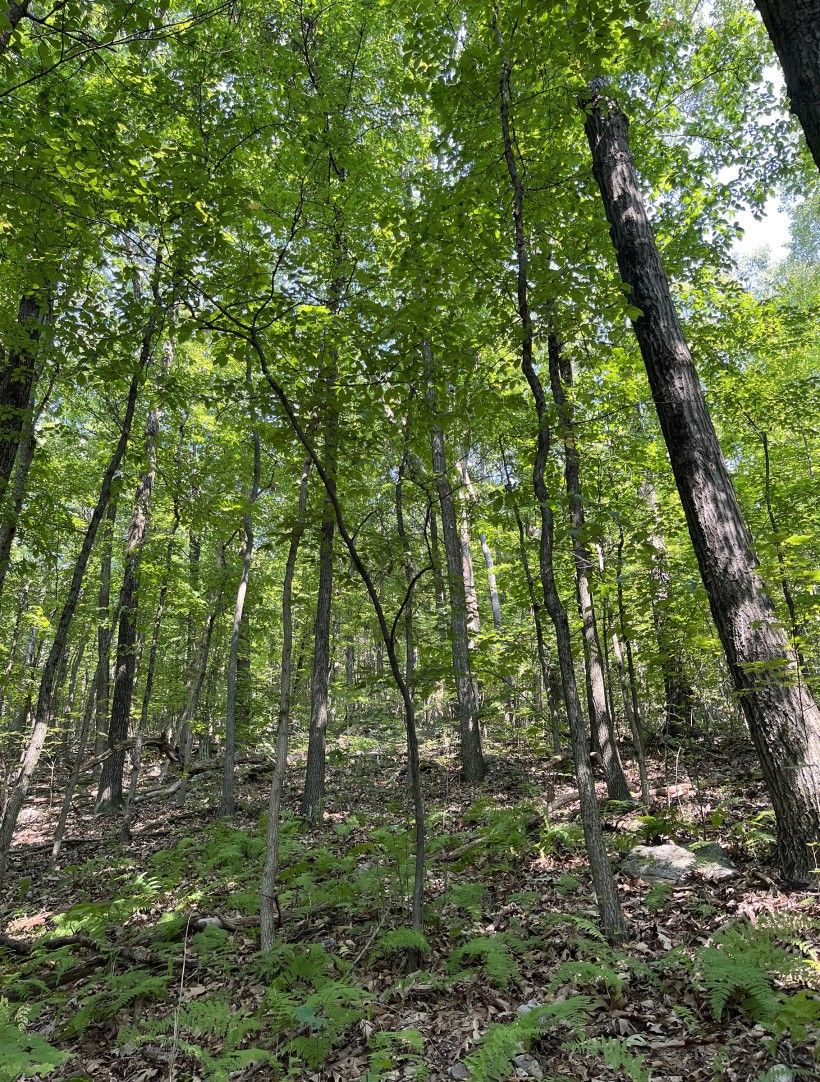
History and Composition of Dry Oak – Mixed Hardwood Forests
As with any forest community, we will evaluate the historic composition of Dry Oak – Mixed Hardwood Forests in three “layers”: the overstory, which contains trees that make up the canopy; the midstory, which contains shrubs and suppressed trees; and the understory, which contains herbaceous species and tree seedlings.
In the overstory, white oak (Quercus alba), chestnut oak (Quercus montana; formerly Q. prinus), black oak (Quercus velutina), and northern red oak (Quercus rubra) dominated, pignut hickory (Carya glabra), shagbark hickory (Carya ovata), and shellbark/bitternut hickory (Carya cordiformis) were common, American chestnut (Castanea dentata), white ash (Fraxinus americana), basswood (Tilia americana), sweet birch (Betula lenta), northern hackberry (Celtis occidentalis), red maple (Acer rubrum), and sugar maple (Acer saccharum) were associates. Pitch pine (Pinus rigida), Virginia pine (Pinus virginiana), and eastern white pine (Pinus strobus) could also be occasionally found in the overstory. The midstory shrub layer consisted of flowering dogwood (Cornus florida), witch hazel (Hamamelis virginiana), maple-leaved viburnum (Viburnum acerifolium), hornbeam/musclewood (Carpinus caroliniana), beaked hazelnut (Corylus cornuta), shadbush/serviceberry (Amelanchier arborea), hop-hornbeam/ironwood (Ostrya virginiana), lowbush blueberry (Vaccinium pallidum), and deerberry (Vaccinium stamineum). Finally, the understory herbaceous layer consisted of false Solomon’s-seal (Polygonatum biflorum), ebony spleenwort (Asplenium platyneuron), poverty grass (Danthonia spicata), tick-trefoil (Desmodium spp.), rattlesnake weed (Hieracium venosum), wild sarsaparilla (Aralia nudicaulis), Pennsylvania sedge (Carex pensylvanica), fibrous-root sedge (Carex communis), and whorled loosestrife (Lysimachia quadrifolia).
No vegetative community occurs at random or by accident. A community’s species composition is dictated by a combination of abiotic site conditions and ecological disturbance regimes, which filter out certain species based on limiting factors in their life history. The most determinant abiotic site conditions that affect species composition are moisture regime and soil composition. Dry Oak – Mixed Hardwood Forests occur on dry, moderately acidic to moderately calcareous soils. This translates to moderately low moisture availability and moderately poor-to-rich nutrient availability. Drier moisture regimes favor oak and hickory reproductive strategies, which involve producing large, locally dispersed seeds with thick protective pericarps (shells), strong taproots, and large cotyledons (flesh) to fuel the germinating seedling. These adaptations prevent the seed from dying as it sits on the forest floor and experiences heat stress. Small seeds that lack these traits, such as tuliptree seeds, generally desiccate and die before establishing in the soil, resulting in a low occurrence of such species.
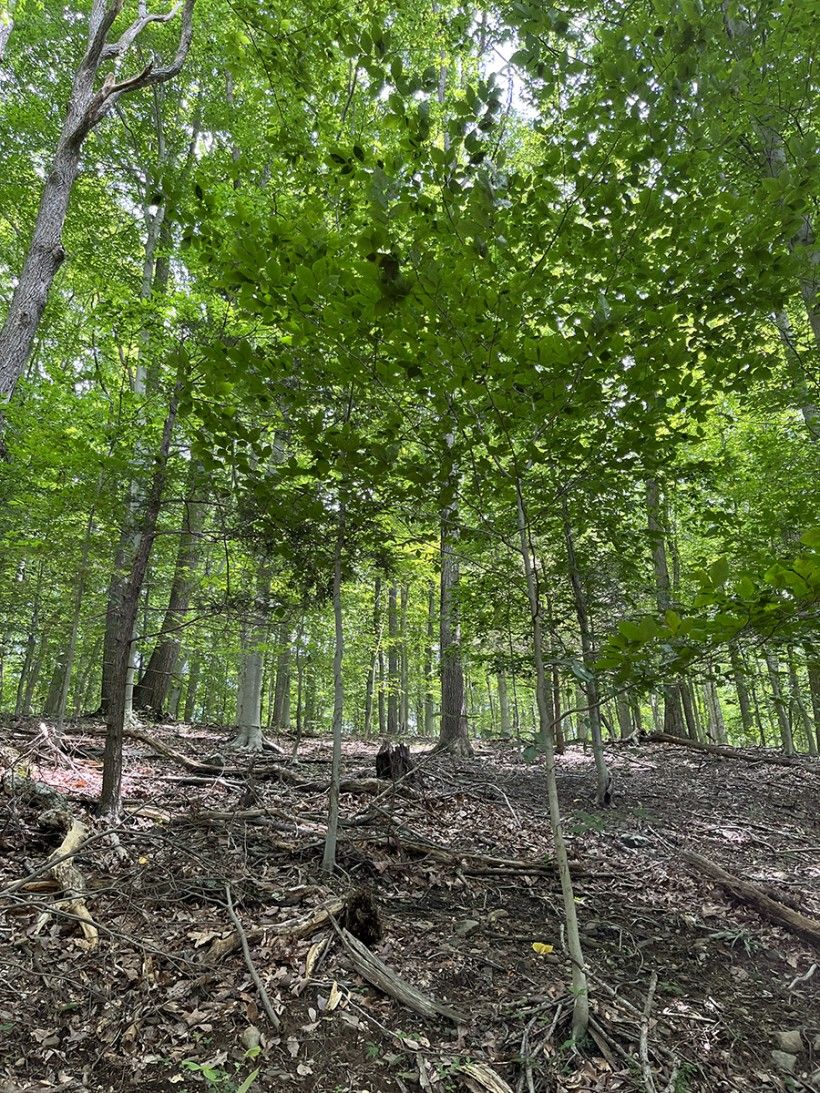
Dry Oak – Mixed Hardwood Forests also tend to occur on south- and southwest-facing upper slopes. Slope position and aspect (the direction that a slope faces) interact with soil composition and moisture regime to further influence moisture and nutrient availability. South-facing slopes in the northern hemisphere receive more sunlight throughout the day, resulting in higher temperatures, greater rates of evaporation and, overall, a larger moisture deficit than that found on north-facing slopes. This moisture deficit, combined with the dry soils, further selects for drought-tolerant species. The USDA Forest Service Silvics of North America provides an extensive review of the life histories of tree species found in the United States.
Ecological disturbances also play a crucial role in determining the composition and structure of vegetative communities. In drier communities, like Dry Oak – Mixed Hardwood Forests, wildfires and prescribed burns have historically been the primary management technique for preserving relatively-open canopies that allow gap-phase species to outcompete shade tolerant species. Gap-phase species are those species which can persist the longest in the understory of a forest as seedlings with moderate shade and then grow into the canopy when a larger opening is created.
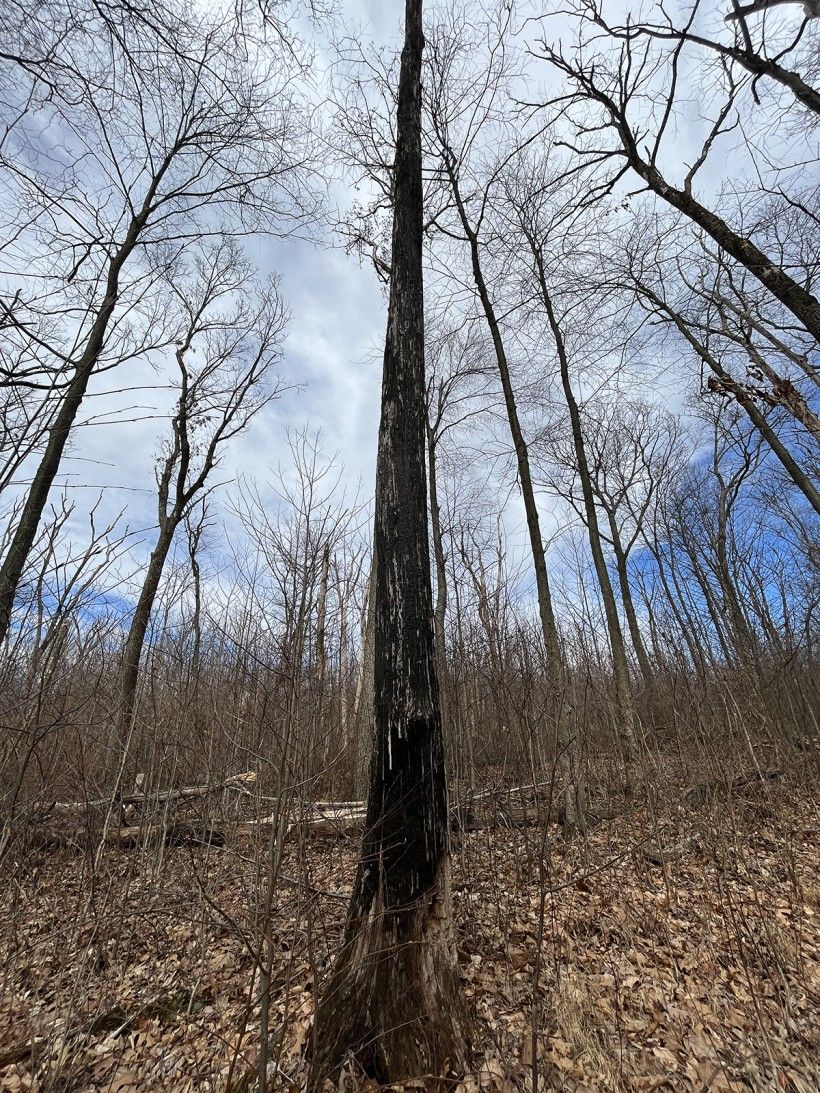
Historically, wildfires in the northeastern United States occurred in the spring and fall, when the days are still moderately long but deciduous trees do not have leaves, allowing sunlight to penetrate to the forest floor and heat the layer of leaf litter and allow something like a lightning strike or an intentional initial fire to start a ground fire. These low-intensity ground fires “creep” along the forest floor and consume leaf litter and competing shrubby vegetation but spare mature overstory trees that have fire adaptations like thick bark. In this way, fire both kills competing vegetation and contributes to the site conditions conducive to oak and hickory regeneration.
These fires contrast with the wildfires in Quebec and the Maritimes this past summer which brought smoke and hazardous air quality to the eastern US for several days. These wildfires occurred outside of the historic fire season during an unusually dry and hot period, resulting in fires of greater intensity and severity. Rather than simply burning the understory, these fires consumed overstory canopy trees as well. Additionally, decades of fire suppression, a practice that most American states, including Pennsylvania and Delaware, have engaged in as well, resulted in unusually high densities of dead wood and other fuels, further contributing to the heightened intensity. Using prescribed fires at the appropriate times is the best way to avoid catastrophic situations like these while also enhancing forest health. Policies like Pennsylvania’s Prescribed Burning Practices Act, passed in 2009, are beginning to enable land stewards to make that management decision.
Threats and Challenges to this Community
Dry Oak – Mixed Hardwood Forests face several challenges, some of which most forest types in our region experience, while others are unique to this species composition. Deer browse continues to threaten the viability of natural regeneration as deer eat tree seedlings that would otherwise form the next cohort of saplings and, eventually, dominant canopy trees. Historically, predation and habitat constraints would have suppressed the deer population and minimized this pressure, but the removal of predators and the dramatic increase in edge habitat has allowed white-tailed deer populations to flourish. Researchers at Penn State, though, believe deer browse is secondary to under-management in threatening Dry Oak – Mixed Hardwood Forests.
Whether in the form of no-cut management or fire suppression, under-management has contributed the most to the conversion of these communities. Fire suppression and delayed timber harvests have allowed these communities to grow artificially dense (or “overstocked”), in turn allowing shade-tolerant species like red maple to establish and outcompete the traditional dominant, gap-phase species like oaks and hickories. On the other hand, where timber harvests do occur, poor forest management practices like high grading have reduced the relative dominance of economically desirable oaks and hickories (which can fetch timber prices in southeast PA 1.69 to 2.75 times higher than competing red maple).

Lastly, pests and pathogens pose a threat even in communities where everything else is managed properly. Bacterial leaf scorch, a disease caused by the bacterium Xylella fastidiosa, clogs the xylem of red oaks and can result in mortality within five to seven years. Oak wilt disease, a fungal disease that can kill red oaks within as little as a few weeks after infection, has not yet been detected in Delaware or southeastern Pennsylvania but has been detected in western Pennsylvania and Maryland.
Defoliator pests like the spongy moth (Lymantria dispar dispar) caterpillar, which primarily threatens forests in central and western Pennsylvania, can cause significant stress to deciduous hardwood species and leave them susceptible to other diseases. Unlike Tuliptree – Maple – Beech Forests, invasive plants species do not currently pose a significant threat in Dry Oak – Mixed Hardwood Forests, though certain species like Japanese stiltgrass (Microstegium vimineum) and multiflora rose (Rosa multiflora) can still displace native species.
Opportunities for Enhancement
As with Tuliptree – Maple – Beech Forests, land stewards have several opportunities to improve the health of Dry Oak – Mixed Hardwood Forests through management. The three challenges to these communities that land stewards can manage against are 1.) overstocking, 2.) insufficient regeneration, and 3.) stress. Stewards can address these at both a macro and a micro scale, in both woodlots and backyards, to meet several goals, including improved wildlife habitat, aesthetic and recreational quality, or timber production.
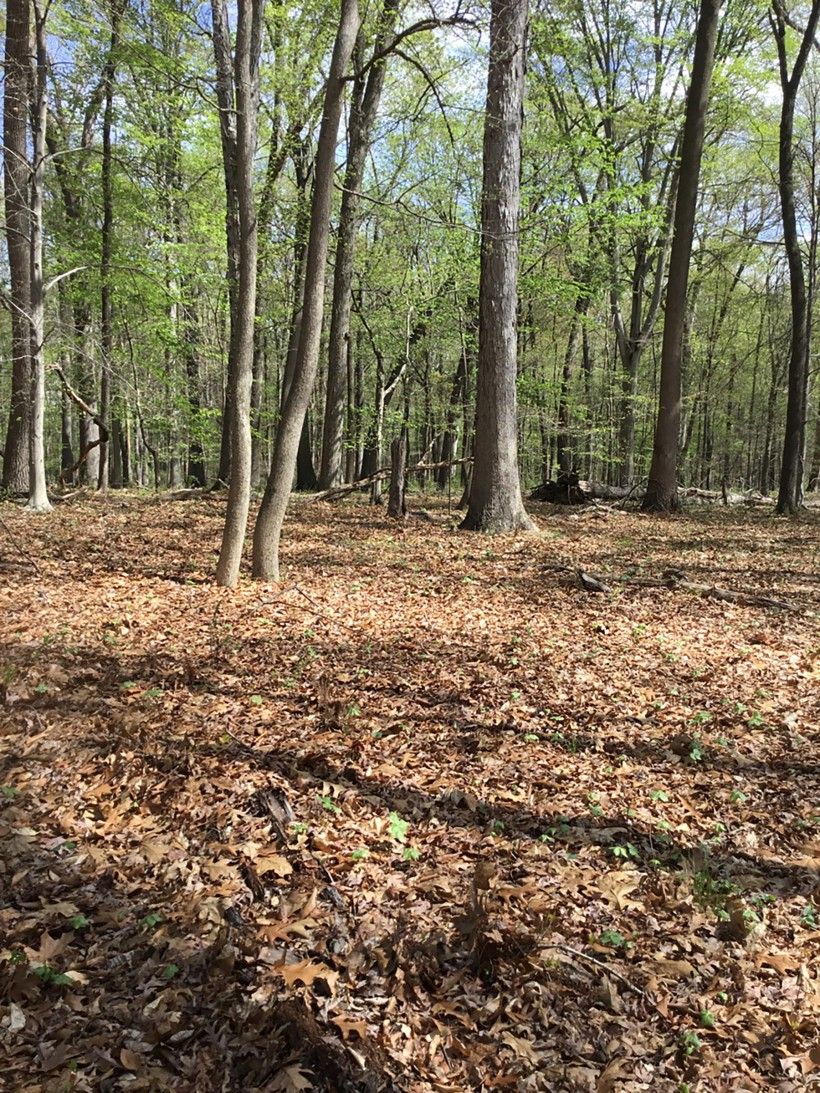
At the macro scale, land stewards should hire a consulting forester who can determine what challenges are most immediate in a particular forest stand and produce a forest management plan to address those challenges. A good consulting forester will produce a plan based on the land steward’s goals for the stand. The Association of Consulting Foresters maintains a list of consulting foresters organized by state, and both the PA DCNR and the Delaware Forest Service both offer landowner assistance as well. A small-group selection timber harvest will likely be recommended to ameliorate overstocking, removing undesirable shade-tolerant species like red maple and reducing the canopy density to allow the regeneration of gap-phase oaks and hickories. This should occur in conjunction with deer management and will likely require regeneration surveys to determine if replanting or competing vegetation management will be necessary.
Prescribed burns, a practice that is less common but shouldn’t be, will also help achieve the same results as a partial harvest. Both Pennsylvania and Delaware have their own permitting procedures for conducting prescribed burns on private lands. Stress from pests and diseases is more difficult to manage, particularly if the pests and diseases are endemic. Diseases depend on a susceptible host, a conducive environment, and a virulent pathogen. At a macro scale, an individual land steward should focus on actively managing the “susceptible hosts” by increasing species diversity through plantings and taking preventative measures by monitoring a stand for signs of disease, especially during periods of environmental stress like drought.
At the micro scale, backyards within the Piedmont ecoregion on a south-facing slope at moderate elevation have a good chance of once resembling a Dry Oak – Mixed Hardwood Forest. To recreate the structure of the previous vegetation type, land stewards should focus on planting species historically found in those vegetation types. Our Native Plant Pocket Garden Series offers guidance for how to do this effectively in anything from a planter to a copse of trees in a yard. As always, planting a variety of species will help to hedge against novel pests and pathogens and will benefit more wildlife guilds. Planting white oaks will reduce the risk of mortality from bacterial leaf scorch, and the list from our most recent native plant and seed sale offers guidance on deer resistant herbaceous and shrubby species like Pennsylvania sedge.
References:
- NCSU: "Why Canada’s Wildfires Are So Bad This Year"
- PNHP: "Dry Oak - Mixed Hardwood Forest"
- PSU: "Deer browsing is not stopping the densification of Eastern forests"
- PSU Extension: Pennsylvania Timber Market Report, First Quarter, 2023
- PSU: Pa. private forest landowners want to use controlled fire to manage their woods
- TNC: Northeastern Interior Dry-Mesic Oak Forest
- UD Cooperative Extension: Bacterial Leaf Scorch
Header image: Amos Oliver Doyle, CC BY-SA 3.0, via Wikimedia Commons